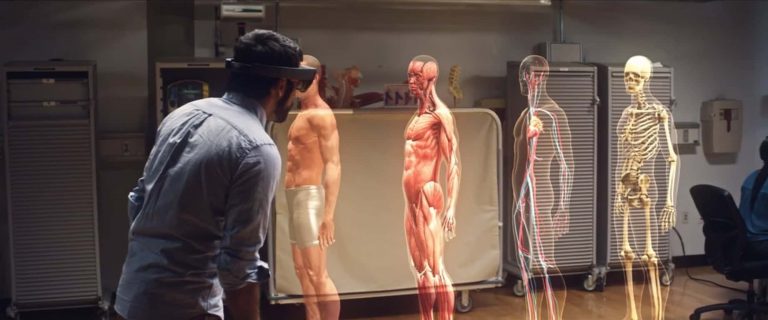Ever since its introduction, Microsoft has been touting use cases for HoloLens – and augmented reality in general – to enhance our workspace. The visions look impressive enough on marketing materials, but what do real-life experts think after actually getting their hands on one? Meet Justin Barad, a board eligible pediatric orthopaedic surgeon from Stanford’s Biodesign program, who put on the HoloLens to give us our answer, which he described in a new article on Medgadget.
It should be noted that Barad is a well-qualified, and rather interesting, individual to give an opinion on HoloLens, being both an accomplished surgeon whose CV include Harvard and Boston Children Hospital, and the Founder and CEO of Osso VR, a surgical simulation company. While his company’s name gives away the man’s interest in virtual reality (VR), he seems to be equally keen on Augmented Reality (AR), which is what the HoloLens is all about. And he has some pretty positive things to say about his experience with Microsoft’s headset.
From his article, Barad seemed to have been put through the usual HoloLens demo routine, which includes putting the headset on, looking around, testing out the controls, setting up a virtual holographic space, and trying out some entertainment, in this case “Project X-Ray“.
Overall, Barad’s words echo what journalists (including ours) have been saying after their stint with the HoloLens: headset is comfy on the head once adjusted, gesture controls are easy and intuitive, if a bit simplistic at this point (he didn’t try voice control much), placing holograms of objects and programs around the real space is a magical experience, and the game was a blast. Barad was especially impressed at the holograms’ clarity, and the headset’s ability to track the 3D space and adjust projections accordingly, making them more real than ever.
Of course, things are not all roses and sunshine, but this is where Barad’s opinion divert back to his home base of expertise. It’s impossible to not talk about the limited field-of-view (FOV) of the HoloLens, which at the moment is more like a rectangular box in front of your eyes than what Microsoft usually shows in their videos. Unlike entertainment-focused tech heads who denounced the headset for this limitation, however, Barad doesn’t seem to think it would be much of a problem, at least in medical applications:
Now it’s time to talk about the elephant in the room, which is the Hololens’ limited field-of-view (FOV). You only see holograms in a small box in the center of your vision. So when you see promotional videos with a room filled with holograms, it’s a little misleading. While the object data for those holograms are there, you really have to scan your head around to see it all. Now, from a gaming/entertainment perspective this may be a deal-breaker at the moment, but for medical applications this might not be a big deal at all.
He also has some pretty interesting ideas for how to use HoloLens in the surgery room, for example to eliminate all the cumbersome tinkering with data video feeds and monitors during an operation; the gesture system will also make it easier to control these feeds. Another use for the HoloLens is to “see through” patients (for example, to look at the spine), using scanned images. The HoloLens will also allow surgeons to guide others remotely, called “telementoring”.
According to Barad, there are still some unclear limitations of the HoloLens in surgical operations that may have to be tested out in a real setting. These include holograms visibility and gesture recognition under harsh surgical lighting conditions, HoloLens’ tinted visor affecting surgeon’s vision, as well as sufficient bodily-fluid-proof and eye protection capability. These are all “relatively minor in the grand scheme of things” in his own words, however, and as this expert surgeon gets hyped for HoloLens’s future development, we are also excited to see how Microsoft will advance its headset and the technology in the future, to truly revolutionize the way we work.


